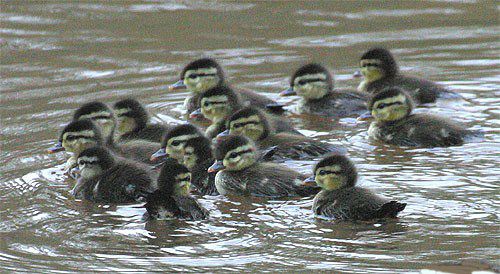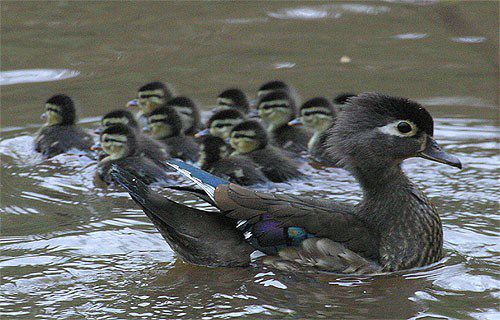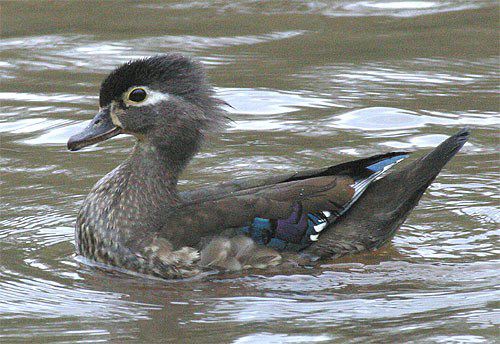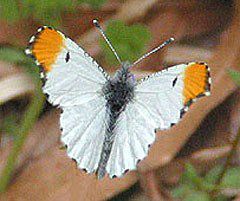|
|
|||
|
|
|||
THIS WEEK at HILTON POND
22-31 March 2003
Back to Preceding Week; on to Next Week
|
NICE WEATHER FOR DUCKLINGS The winter of 2002-2003 has brought considerable and much-needed precipitation to Hilton Pond Center, finally raising the pond itself to the full mark for the first time in four years. As spring arrived this week, the rains continued, including another 1.2" downpour that began on the evening of 29 March. At sunrise on the 30th our local skies were still overcast and light rain continued to fall--"nice weather," as they say, "for ducks." Sure enough, when we looked out at Hilton Pond from our office window we noticed a male Wood Duck with raindrops rolling off his back, but he demonstrated the previously unobserved behavior of paddling around rapidly in wide circles. We watched him for a few minutes until a female woodie cruised into view--followed by a dark shadow that we thought at first might be a River Otter or Snapping Turtle seeking a waterfowl breakfast. Grabbing our binoculars, we zoomed in on the female duck and discovered instead she was accompanied by a whole potful of downy creatures--our first Wood Ducklings of the year, and the likely cause of the male duck's agitated behavior.  One of the first things we did after moving to Hilton Pond Center in 1982 was erect six Wood Duck boxes (below left) supplied by South Carolina's Department of Natural Resources. Four of these are on Hilton Pond itself, and two more sit near our end of another larger pond that is partly on Center property. Early each winter we carefully clean out our nestboxes, removing old egg shells and other detritus--including sticks occasionally deposited by Gray Squirrels that somehow get into the boxes despite the skirt-like predator guards. (Squirrels are pretty smart at getting into "squirrel-proof" bird feeders, so perhaps they've also learned how to parachute.) Then we add several scoops of wood shavings to the bottom or each box, replicating the substrate of abandoned Pileated Woodpecker cavities in which Wood Ducks sometimes nest. As laying begins, the female duck invariably plucks enough of her downy breast feathers to cover the shavings and surround the eggs (below right). Our local female Wood Ducks, Aix sponsa, begin to lay their creamy white eggs as early as the first of February, adding one each day until the clutch is complete. Our biggest clutch in a nestbox was 26, but that may have been a "dump nest" in which several females laid eggs that did not hatch and that may never have been incubated. In the typical one-female nest, incubation does not begin until the clutch is complete. Since embryo development is triggered by the warmth of incubation, a female that waits insures that all eggs develop at the same rate and hatch synchronously at about the 30-day mark.  On hatch day, the female leaves the nest and calls up to her newly hatched ducklings, which pop one by one from the nest hole and flutter down, splashing into water or bouncing harmlessly on soft ground beneath. The female chirps at her brood, keeping them together until the last sibling has jumped, and then it's off to teach them what they need to learn to be successful in the Wood Duck world. In the case of the brood that hatched from our Nest Box #1 on 30 March, herding offspring was no easy task; we could see through our binoculars that the female had produced 16 energetic ducklings that bobbed like fluffy little corks on Hilton Pond.
 We made no attempt to capture any of the ducklings. Banding waterfowl requires a special permit and is usually left to state and federal wildlife officials who use their data to determine bag limits for duck hunters. Besides, unlike songbirds that are essentially full-grown when they leave the nest, ducklings steadily increase in size for a few months after fledging. Thus, ducks are not banded until they--and their legs--become adult-sized. We did accidentally net a bunch of baby Wood Ducks one spring. After hatch date, the female often takes off through the woods with her brood waddling along behind, perhaps in search of a larger body of water or one with a different variety of food. NOTE: See Wood Duck Nestboxes for plans and instructions for an easy-to-make artificial cavity. If you enjoy "This Week at Hilton Pond," please help Support Hilton Pond Center for Piedmont Natural History. It's painless, and YOU can make a difference! You may wish to consult our Index of all nature topics covered since February 2000. For a free, non-fattening, on-line subscription to "This Week at Hilton Pond," just send an e-mail with "Subscribe" in the subject line to THIS WEEK |
|
Participate in the Operation RubyThroat: The Hummingbird Project by clicking on the link above |
|
SPECIES BANDED THIS WEEK * = New species for 2003
NOTABLE RECAPTURES (with original banding date, sex, and current age) Chipping Sparrow (3) 01/25/00--after 4th year unknown 02/29/00--after 4th year unknown 02/27/02--after 2nd year unknown Northern Cardinal (2) 06/27/98--6th year male 01/17/99--after 5th year female White-throated Sparrow (6) 01/09/99--after 5th year unknown 11/06/00--4th year unknown 11/06/01--3rd year unknown 11/06/01--3rd year female 11/26/01--after 2nd year unknown 11/30/01--3rd year female Eastern Bluebird (1) 07/11/01--3rd year male House Finch (2) 12/19/00--after 3rd year male 02/18/01--after 3rd year male
VAGRANT HUMMINGBIRDS A female Rufous Hummingbird was banded at Seneca SC on 31 Mar. |
WEEKLY BANDING TOTAL YEARLY BANDING TOTAL (2003) 17 species 424 individuals BANDING GRAND TOTAL (since 28 June 1982) 123 species 42,538 individuals
OTHER SIGHTINGS OF INTEREST  --On 28 Mar, an early male Falcate Orangetip (above) fed on Bluets and Johnny-jump-up flowers and became the 20th butterfly species positively identified at Hilton Pond Center. |
Back to Preceding Week; on to Next Week
|
Up to Top of Page Back to This Week at Hilton Pond Center Current Weather Conditions at Hilton Pond Center |
If you enjoy "This Week at Hilton Pond," please help support Hilton Pond Center for Piedmont Natural History. It's painless, and YOU can make a difference! (Just CLICK on a logo below or send a check if you like; see Support for address.) |
|
Make credit card donations on-line via Network for Good: |
|
Use your PayPal account to make direct donations: |
|
If you like shopping on-line please become a member of iGive, through which 1,200+ on-line stores from Amazon to Lands' End and even iTunes donate a percentage of your purchase price to support Hilton Pond Center.  Every new member who registers with iGive and makes a purchase through them earns an ADDITIONAL $5 for the Center. You can even do Web searches through iGive and earn a penny per search--sometimes TWO--for the cause! Please enroll by going to the iGive Web site. It's a painless, important way for YOU to support our on-going work in conservation, education, and research. Add the iGive Toolbar to your browser and register Operation RubyThroat as your preferred charity to make it even easier to help Hilton Pond Center when you shop. Every new member who registers with iGive and makes a purchase through them earns an ADDITIONAL $5 for the Center. You can even do Web searches through iGive and earn a penny per search--sometimes TWO--for the cause! Please enroll by going to the iGive Web site. It's a painless, important way for YOU to support our on-going work in conservation, education, and research. Add the iGive Toolbar to your browser and register Operation RubyThroat as your preferred charity to make it even easier to help Hilton Pond Center when you shop. |
|
|
Dell Inkjet Cartridge
The link above is required by a Web site that provides us with a free page counter.
You are not obligated to click on the link.